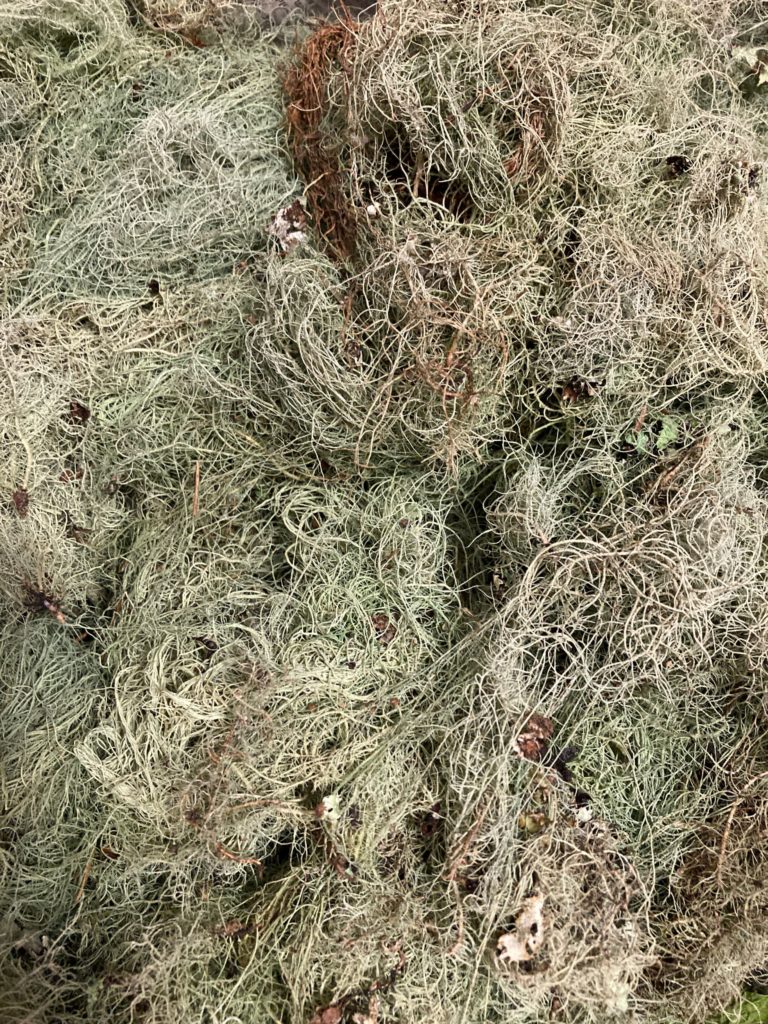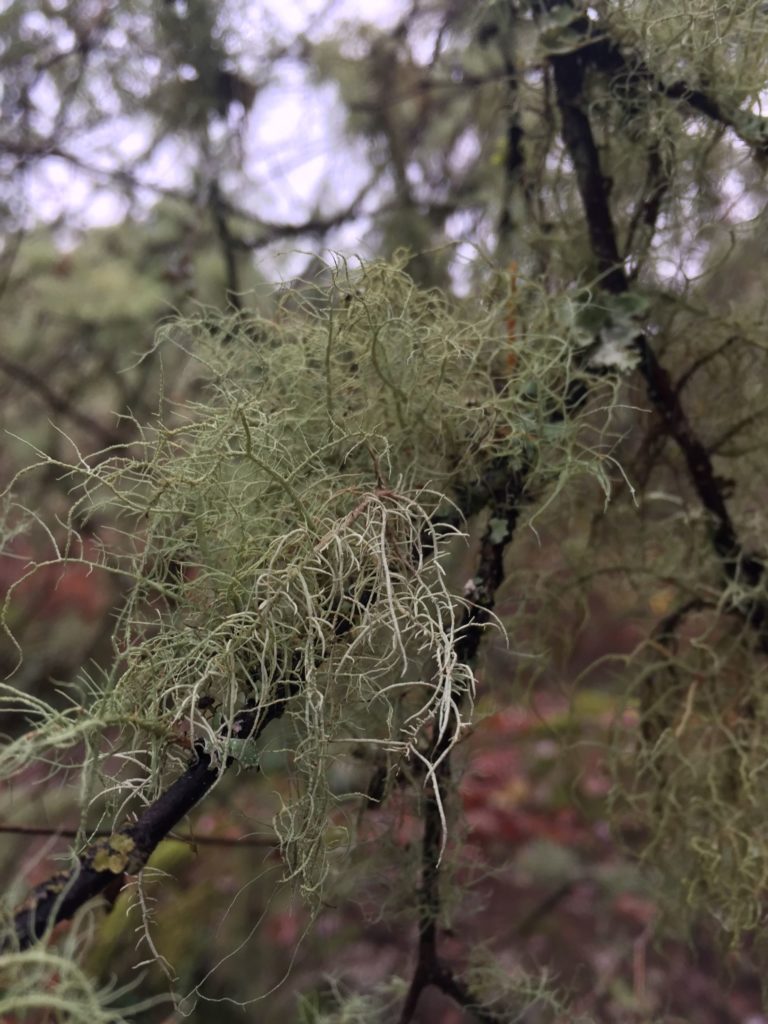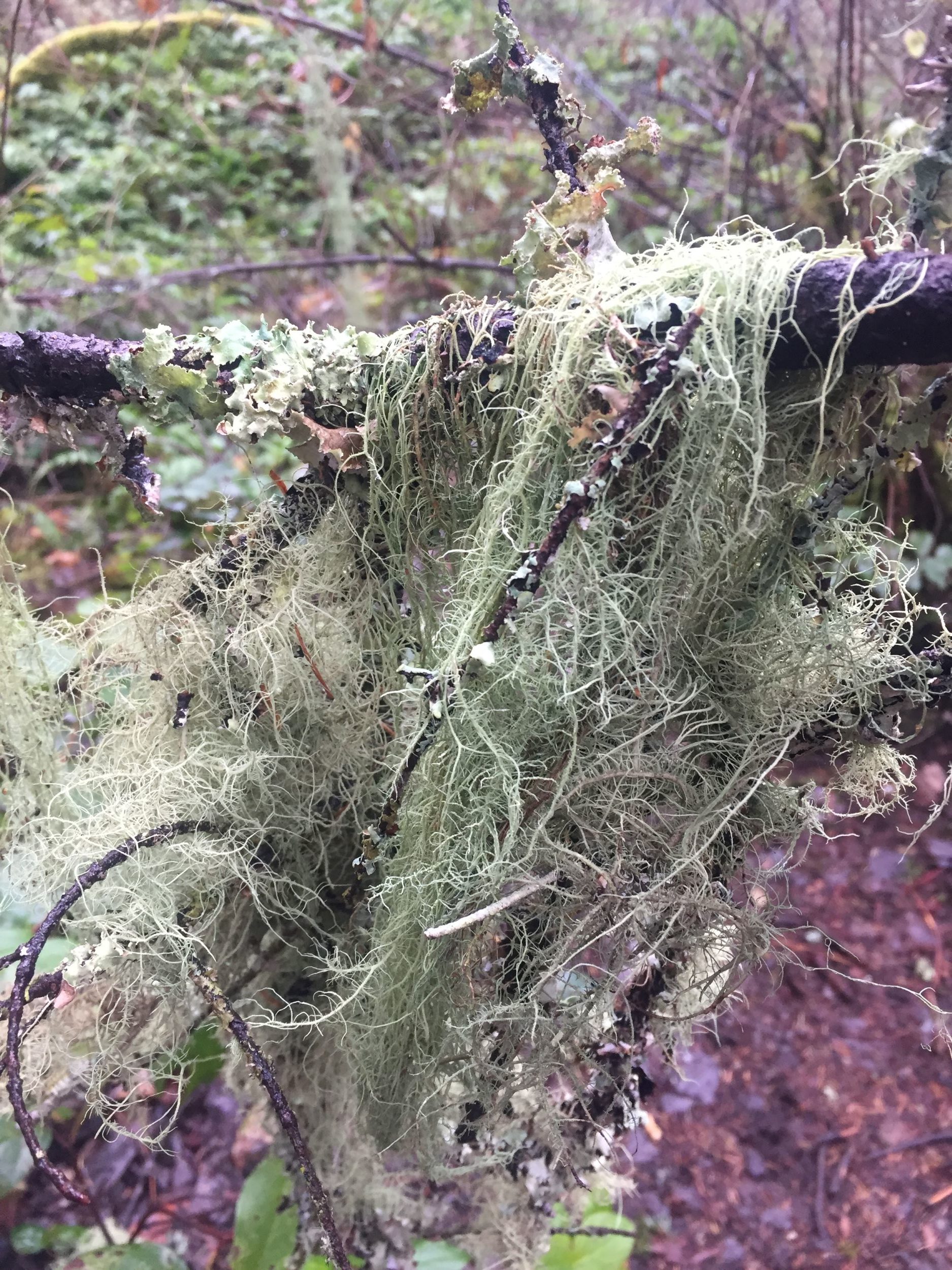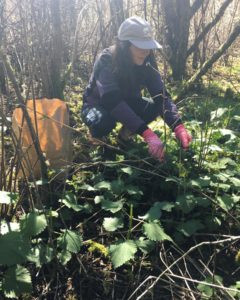Think foraging is over for the season? Think again! The days are colder and shorter, but Gaia never fails to provide for all creatures. Though it tends to be more challenging to spend time outside in winter, I find that in this season it is even more important for my mental health to commune with nature. I appreciate observing how plants endure the winter – they have a peaceful slowness, though already I see leaf buds forming on osoberry bushes in preparation for the spring and baby cleavers and fringecups dotting the forest floor. Walking in the woods after a winter windstorm (but not during!) is my favourite time to keep my eyes peeled for fallen bits of forest medicine. One of the most common gifts I find is usnea.
You’ve probably seen usnea, also known as Old Man’s Beard, hanging from trees, especially conifers, in the forest. Its common name refers to its long, beard-like, ‘hairy’ growth form. It is a lichen, which means it is a symbiosis of fungus and algae. While lichens were initially understood to be comprised simply of one fungus, which provides structure, and one algae, which photosynthesises, recent research has shown that there are often multiple fungi and/or other microbial players (such as cyanobacteria) involved. In the case of usnea and other “beard-like” lichens in North America, Spribille et al. found that a specific group of yeast is also involved in this symbiosis. This is big news in the lichenology world! Read more about it here.
Usnea is found worldwide, though in North America it is most abundant and large in the Pacific Northwest, particularly in old growth Douglas Fir forests. Here on Vancouver Island, the two predominant species are Usnea longissima (which has a longer growth form) and U. wirthii (which is tuftier and shorter). Usnea is hair-like and a pale yellowish-grey-green, with round filaments. There are a few lookalike lichens in the area, so a surefire way of identifying usnea is to pull it gently apart and look for a white elastic core at the centre of the thallus. This will only really work with damp or fresh usnea, which is fine as you don’t want to collect old lichen anyways.
Usnea is a bioindicator for clean air as air pollution disrupts its metabolic processes and prohibits growth. Between deforestation and increased air pollution, the lichen is becoming increasingly threatened. It also has an extremely slow growth rate, which means that it should only be harvested from the forest floor when it is no longer actively growing. Its predominant means of reproduction is through fragmentation (which is kind of like the lichen version of self-propagation, where a bit will break off and colonize a new spot), meaning that even collection from windfall should be conservative. It is vital to leave enough for animal use too – usnea is used as forage, medicine, and nesting material for animals and provides habitat for insects and microorganisms.

Usnea has a long history of medicinal use, with records dating back to around 101 B.C.E. in Ancient China, 400 B.C.E. in Ancient Greece, and 9th century C.E. in modern-day Iraq. It also has a long history of indigenous use in North America. While traditional usage tends to vary based on geographic area, all species are immune-stimulating, antimicrobial (antifungal, antibiotic, antiviral, and antiparasitic), anti-inflammatory, and analgesic. Herbalist Stephen Harrod Buhner specifies that usnea works especially well on mucous membranes, including the throat, sinuses, lungs, intestines, urinary tract, and reproductive system, and that it also supports tree and ecosystem health. Even birds use usnea, along with other antimicrobial herbs, to build their nests, thus protecting chicks from harmful pathogens.
The most widely studied component of usnea is usnic acid, which is antibiotic. It specifically works against gram-positive bacteria (which have a different cell wall and result in different infections than gram negative bacteria), which include Listeria, Streptococcus, and Staphylococcus. These bacteria can lead to infections including diptheria, bacterial bronchitis and pneumonia, meningitis, necrotizing fasciitis, strep throat, athlete’s foot, toxic shock syndrome, sepsis, and tuberculosis. As antibiotic resistance becomes increasingly problematic, usnea provides an intriguing alternative to synthetic antibiotics, particularly as it also causes less disruption to the human microbiome. Usnea has also been found to help fight Epstein-Barr virus and herpes simplex. It is contraindicated with pregnancy, so skip any internal use if you are expecting.

Usnea can be used topically or internally. It does not readily extract into water; therefore, a tincture is more appropriate for internal complaints, though a decoction could also work in a pinch. Externally, a wound powder can also be applied to skin infections, and usnea also extracts easily into oil, which can then be used on its own or made into a salve and applied to wounds, burns, or infections. One study found that usnic acid is potentially hard on the liver. Though the use of usnic acid as an isolate is much different than the use of usnic acid in synergy with the rest of the phytochemicals (and is also used in much higher quantities than naturally occurring), it is always wise to proceed with caution and discontinue use if you experience any adverse reactions.

